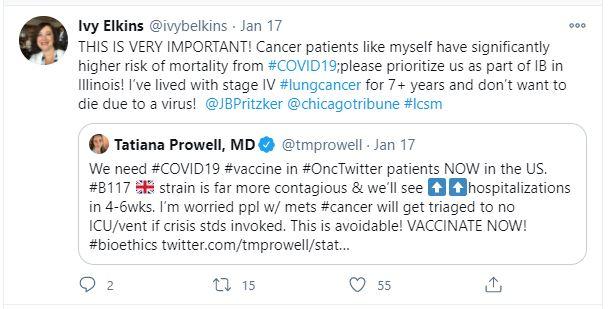Even those who are unfamiliar with social media platforms can find Twitter to be an easy way to discuss research and collaborate with colleagues.
If you do not already have a Twitter account, you should consider setting one up now! During a virtual conference, Twitter is the best possible replacement for the hallway conversations that take place naturally at in-person conferences. Using Twitter at this year’s WCLC will help you share information, connect with people, and be part of the conversation about new research and treatment options.
Taking screenshots from sessions is a very helpful way to share information with others and talk about the implications of presented results. When sharing information from a presentation, make sure to tag (and follow) the presenter (if on Twitter) and the institution/organization. It’s always a good idea to add your interpretation of a screenshot that you share as a comment. Often when tagged, presenters or their institutions will retweet your tweet and sometimes add something to the conversation. Just pay careful attention to make sure that you are not sharing anything marked “Do Not Post”; sometimes these warnings are marked in very small letters in corners of slides!
By including @IASLC, #lcsm (which stands for “lung cancer social media”) and the conference hashtag #WCLC20 on any tweets you create, you will broaden your audience. Watching the latest and top posts from #WCLC20 will allow you to keep abreast of exciting news that will be happening in concurrent sessions that you are unable to attend. Feel free to retweet these tweets as well, adding your own comments as you repost. Your tweets will gain more attention and you will likely come to attract more followers by adding your opinions than merely retweeting without additional comments.

If you are watching a presentation and have a question that either you cannot submit through the conference platform due to timing or is not selected for discussion during a live Q&A, this is a great opportunity to use Twitter to reach out to the presenter. In order to do this, you can send a message using the Direct Message (DM) Twitter option, which ensures that the message stays private. When you DM someone, make sure to introduce yourself and thank the person for their presentation before asking your question respectfully.
This brings up another topic — your own personal Twitter profile. People will use this profile to check your legitimacy and make decisions about answering your DMs or following you. Make sure your profile is as complete as possible given the 160-character limit — include a picture, your full name, organization, connection to lung cancer if not obvious, and any other information that might be pertinent. Be sure to verify new connections via their profiles as well, which ideally will be as updated as yours. If a person’s profile is incomplete or seems completely unrelated to lung cancer, you should avoid following them. It is also a good idea to watch and see who likes and retweets your posts, as these could be important contacts for you in the future. Consider following these people to expand your Twitter circle and more easily engage in conversation.
Hopefully through active Twitter participation, you will gain followers, expand your influence and understanding regarding presented material, and make some new connections during WCLC. Many patient advocates like myself participate actively in WCLC and by following us, you might get a new perspective on some of your tweets!
About the Author:
Ivy Elkins (@ivybelkins) is a patient advocate and member of both the IASLC Patient
Advocacy Committee and the IASLC Lung Cancer News Editorial Group. She is also a 7+ year lung cancer survivor and the co-founder of the lung cancer patient advocacy group, the EGFR Resisters (@EGFRResisters).






